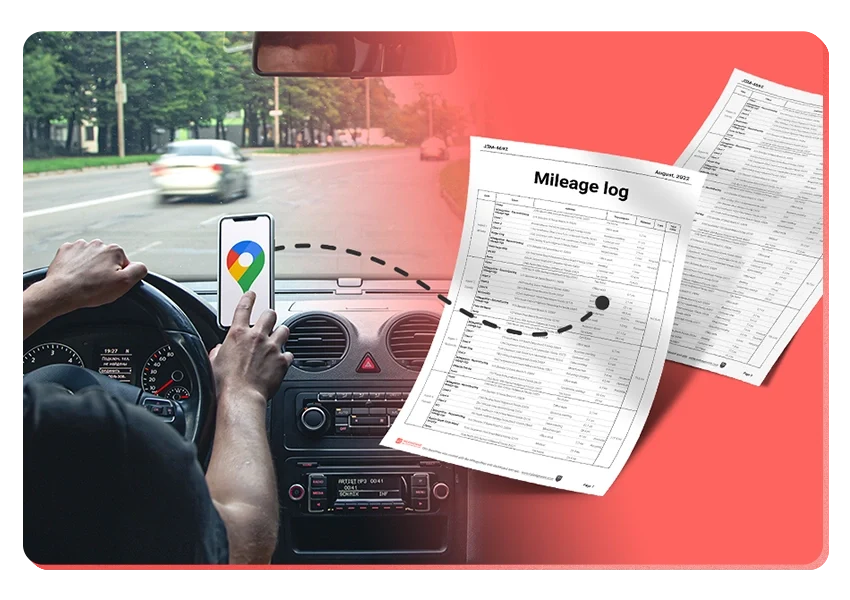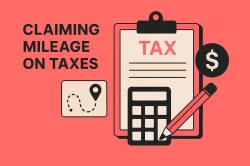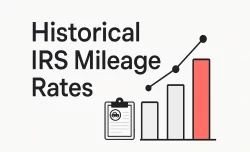Table of Contents
What Is a Mileage Deduction?
A mileage deduction allows individuals and businesses to reduce their taxable income by accounting for the business use of a personal vehicle. Claiming mileage on taxes is possible when a vehicle is used for business, medical, charitable, or, in certain cases, moving purposes.
Deduction Methods
There are two primary methods to calculate deductible vehicle expenses:
1. Standard Mileage Rate
This method involves multiplying the total business miles driven by the IRS-established standard mileage rate. The rate is updated annually and encompasses expenses such as fuel, maintenance, depreciation, and insurance.
Eligibility Criteria:
The vehicle must be owned or leased by the taxpayer.
The standard mileage rate must be chosen in the first year the vehicle is used for business.
The taxpayer must not have claimed depreciation deductions other than straight-line depreciation.
The vehicle must not be part of a fleet of five or more vehicles used simultaneously.
2. Actual Expense Method
This approach requires detailed tracking of all actual vehicle-related expenses, including:
Fuel
Maintenance and repairs
Insurance
Registration fees
Depreciation or lease payments
The deductible amount is calculated based on the percentage of total vehicle use that is for business purposes.
Recordkeeping Requirements
To substantiate mileage deductions, the IRS mandates maintaining accurate and timely records. Essential information includes:
Date of each trip
Purpose of the trip
Starting point and destination
Beginning and ending odometer readings
Total miles driven per trip
Records should be kept contemporaneously, meaning they should be recorded at or near the time of the trip. If the trips are very obviously forged after the fact, the IRS can issue a penalty and revoke your deduction.
Non-Deductible Mileage
It’s important to note that commuting miles—the distance traveled from home to the regular place of work—are not deductible. Only mileage incurred for business-related activities beyond the regular commute qualifies for deduction.
Additional Considerations
Parking Fees and Tolls: These are deductible separately from the standard mileage rate, provided they are business-related.
Charitable Mileage and Medical Mileage: Different rates apply for mileage driven for charitable or medical purposes. These rates are also set by the IRS and are subject to annual updates.
Note that there are many deduction opportunities available for self-employed people. Look for them on official platforms or a deduction finder tool covered in our Everlance review.
For the most current mileage rates and detailed guidelines, refer to the IRS’s official publications or consult a tax professional.
FAQ
What is a mileage deduction?
A mileage deduction allows taxpayers to claim the cost of using their personal vehicle for business purposes as a tax-deductible expense, reducing taxable income.
How do I calculate my mileage deduction?
You can calculate your deduction using either the standard mileage rate set by the IRS or by recording actual vehicle expenses and allocating them proportionally to business use. Apps like Triplog , the Driversnote mileage app, and MileIQ automatically track your miles and calculate your deductions.
Am I eligible for mileage deduction?
You’re eligible for a mileage deduction if you use your personal vehicle for business (for example, if you are a real estate agent), medical, moving (for active-duty military), or charitable purposes.
How does MileageWise simplify mileage deduction tracking?
MileageWise provides automatic mileage tracking, accurate documentation, and simple mileage logs, making it easy to claim your mileage deduction.
Try MileageWise for free for 14 days. No credit card required!
Related Terms

Introducing the Google Timeline to Mileage Log Mobile App
We’re excited to share our latest development! You can now convert your Google Maps Timeline drives directly into an IRS-compliant mileage log right on your

DoorDash Tips and Tricks: Your Edge Over Competition
Last Updated: November 17, 2025 I’m excited to share the top DoorDash tips and tricks shared by YouTuber Pedro “Mr.BetonYou” Santiago. He collected and vetted the

8 Uber and Lyft Scams Every Driver Should Know
Last Updated: November 9, 2025 Driving for Uber or Lyft can be a rewarding gig, offering flexibility and the chance to meet new people. However,
SherpaShare Shutdown – What To Do Now?
Last Updated: October 7, 2025 SherpaShare was a service designed primarily for people who work as independent contractors, particularly those in the ride-sharing and delivery
Gas Mileage Tracker: Your Key to Savings
Last Updated: August 8, 2025 A gas mileage tracker helps drivers watch their vehicle’s fuel use, mileage, and related costs. You might want one to

How To Track Miles on iPhone: Find your Match
Last Updated: August 6, 2025 Looking to track miles on your iPhone? Whether it’s for fitness, personal use, or business tax deductions, your iPhone offers
Related Guides



It’s Finally Here! Google Maps Timeline Import from Mobiles
Transform your Trip Lists into Mileage Logs with MileageWise

Introducing the Google Timeline to Mileage Log Mobile App
We’re excited to share our latest development! You can now convert your Google Maps Timeline drives directly into an IRS-compliant mileage log right on your

DoorDash Tips and Tricks: Your Edge Over Competition
Last Updated: November 17, 2025 I’m excited to share the top DoorDash tips and tricks shared by YouTuber Pedro “Mr.BetonYou” Santiago. He collected and vetted the

8 Uber and Lyft Scams Every Driver Should Know
Last Updated: November 9, 2025 Driving for Uber or Lyft can be a rewarding gig, offering flexibility and the chance to meet new people. However,
SherpaShare Shutdown – What To Do Now?
Last Updated: October 7, 2025 SherpaShare was a service designed primarily for people who work as independent contractors, particularly those in the ride-sharing and delivery
Gas Mileage Tracker: Your Key to Savings
Last Updated: August 8, 2025 A gas mileage tracker helps drivers watch their vehicle’s fuel use, mileage, and related costs. You might want one to

How To Track Miles on iPhone: Find your Match
Last Updated: August 6, 2025 Looking to track miles on your iPhone? Whether it’s for fitness, personal use, or business tax deductions, your iPhone offers

Introducing the Google Timeline to Mileage Log Mobile App
We’re excited to share our latest development! You can now convert your Google Maps Timeline drives directly into an IRS-compliant mileage log right on your

Was Your Google Timeline Deleted? Here’s What Happened:
Last updated: November 20, 2025 If you recently opened Google Maps and noticed your Timeline was deleted or partially missing, you’re not alone. In this

It’s Finally Here! Google Maps Timeline Import from Mobiles
Struggling to Manage Your Trips After Google’s Timeline Update? If you’re reading this, you’ve likely encountered the recent update affecting Google Maps Timeline. With Timeline
Transform your Trip Lists into Mileage Logs with MileageWise
Last Updated: October 1, 2025 Do you have a list of monthly trips from a data source like Excel or Google Timeline, but need to

How to Download Google Timeline Data: A Guide
Google Timeline Import Hub Last Updated: October 30, 2025 Want to download Google Timeline data? This guide shows you how to extract your location history

How to Export Google Maps Timeline: Get Your Data
Google Timeline Import Hub Last Updated: October 29, 2025 It can be tricky to export Google Maps Timeline data after Google’s recent updates. Many users
Google Maps Mileage Tracker: From Timeline to Mileage Log
Google Timeline Import Hub Last Updated: October 29, 2025 If you’re an active user of Google Maps Timeline you likely already know how convenient it
Timeero
Table of Contents Timeero Timeero is a time, location, and mileage tracking app designed for businesses and teams in the United States. It helps employers
Milewise by Allstate
Table of Contents Milewise by Allstate Milewise by Allstate is a pay-per-mile car insurance program offered by Allstate Insurance in the United States. It’s designed
Hurldr
Table of Contents Hurdlr Hurdlr is a finance and expense tracking app designed for self-employed professionals, freelancers, and gig workers in the United States. It








